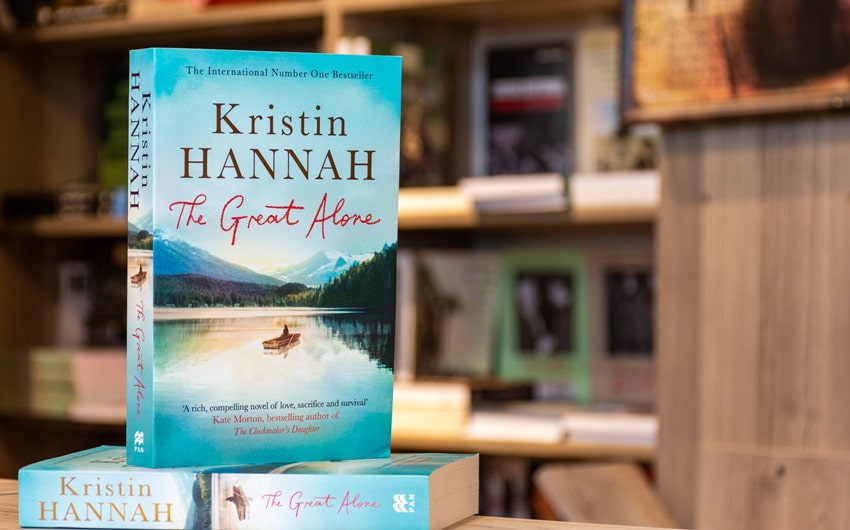The Great Alone: A Story of Survival in Alaska’s Wilderness
Life in the wilderness can be both beautiful and unforgiving, a reality Kristin Hannah captures perfectly in The Great Alone. This compelling novel takes readers on a journey into the heart of Alaska, where a family seeks a fresh start but faces unexpected challenges.
Through themes of survival, isolation, and resilience, The Great Alone explores the emotional depth of human relationships and the impact of trauma. As the characters navigate the wild terrain and their own inner struggles, readers are reminded of the strength it takes to endure life’s harshest trials while holding onto hope.
About the Author: Kristin Hannah
Kristin Hannah is a bestselling author known for her emotionally powerful and deeply resonant stories. With a career that spans several decades, Hannah has written over 20 novels, each exploring themes of family, love, loss, and personal resilience. Her ability to create complex, relatable characters in gripping narratives has earned her critical acclaim and a loyal readership.
Before becoming an author, Hannah worked as a lawyer, but after the birth of her son, she decided to pursue writing. Her early works focused on romance, but she soon expanded into historical fiction and drama, garnering widespread recognition with her breakout novel, Firefly Lane, and later with The Nightingale, which was a massive success. The Nightingale cemented her reputation as a master of historical fiction, and it went on to win several literary awards. It was even adapted into a film, further expanding her reach as an author.
In The Great Alone, Hannah shifts her focus to a more contemporary setting while exploring themes that resonate across her works: survival, trauma, and the indomitable human spirit. With The Great Alone, she once again proves her ability to create compelling stories that blend emotional depth with dramatic storytelling. Her portrayal of characters caught in extraordinary circumstances, set against the vast Alaskan wilderness, showcases her talent for writing novels that both entertain and inspire reflection.

Image source: Pinterest
Overview of The Great Alone
The Great Alone follows the story of 13-year-old Leni Allbright and her family as they relocate to the remote Alaskan wilderness in 1974. After her father, Ernt, returns from the Vietnam War, he is a changed man, struggling with PTSD and unable to reintegrate into society. When a former war buddy leaves him a cabin in Alaska, Ernt sees it as the perfect opportunity for a fresh start, away from the chaos and noise of modern life.
The Allbrights, including Leni’s mother, Cora, arrive in Alaska filled with hope and determination. However, they quickly realize that the challenges of living in such a remote and unforgiving landscape are far greater than they expected. As winter approaches, bringing with it 18-hour nights and brutal conditions, Ernt’s mental state deteriorates further, and the family’s survival becomes uncertain—not just against the elements, but also from within.
Throughout the novel, Leni learns to navigate both the harsh environment and the increasingly volatile atmosphere at home. As she matures, she is forced to confront difficult truths about love, loyalty, and the impact of trauma on her family. The novel’s setting—the wild and untamed Alaska—serves as a powerful metaphor for the struggles the family faces, both individually and together.
Themes of Survival and Isolation
Survival is a central theme in The Great Alone, both in terms of the characters’ ability to physically endure the harsh Alaskan environment and their emotional survival in the face of personal trauma. The family’s decision to move to Alaska represents a desire to escape from the troubles of the world, but they quickly find that isolation only amplifies their problems.
Ernt’s struggle with PTSD becomes more pronounced in the isolation of the wilderness, as he is cut off from any external support systems. The isolation exacerbates his paranoia and instability, putting his family at risk. His erratic behavior and the constant threat of violence create an environment where Cora and Leni must learn to survive emotionally, as much as physically.
For Leni, the isolation offers a dual experience. On the one hand, Alaska represents freedom and a chance for personal growth, as she learns self-reliance and strength from the rugged landscape. On the other hand, the emotional isolation she feels from her increasingly unstable father and her conflicted mother forces her to mature quickly. Alaska’s beauty and danger mirror Leni’s internal struggles, as she learns to navigate both the wilderness and her fractured family dynamics.
Family, Trauma, and Resilience
At the heart of The Great Alone is the complex and often painful dynamic between Leni, her mother Cora, and her father Ernt. Ernt’s return from the Vietnam War sets the stage for the family’s unraveling. His PTSD, which is left untreated, leads to anger, violence, and paranoia, creating a toxic environment that Cora and Leni must endure.
Cora, despite the abuse she faces, remains deeply in love with Ernt and believes that their move to Alaska will heal him. Her loyalty to Ernt, combined with her fear of being alone, traps her in a dangerous cycle of abuse. Cora’s love for Ernt is juxtaposed with her fierce desire to protect Leni, making her character both sympathetic and tragic. Her resilience is tested repeatedly as she navigates the line between hope for her husband’s recovery and the reality of their situation.
Leni, on the other hand, represents a younger generation grappling with the weight of her parents’ trauma. As she grows up in Alaska, she learns the true meaning of resilience—not just in terms of surviving the wilderness but in surviving the emotional turmoil of her family life. Her relationship with her father becomes increasingly strained as she sees the harm he is causing, but her love for her mother keeps her tied to the family’s difficult situation.
Through the lens of family trauma, Hannah explores the themes of loyalty, fear, and the lengths we go to for the people we love. The novel doesn’t shy away from the complexities of domestic abuse and how trauma ripples through generations. But despite the darkness, there is also a message of resilience, as Leni ultimately finds her own path to healing and self-discovery.
The Role of the Alaskan Wilderness
In The Great Alone, Alaska is more than just a setting—it is a character in its own right. The vast, untamed wilderness shapes the story as much as the human characters do. The Alaskan landscape is both breathtakingly beautiful and terrifyingly dangerous, and it plays a central role in the characters’ survival and emotional journeys.
The extreme isolation of their homestead, far from the nearest town, means that the Allbrights are forced to rely on themselves and their small community for survival. The harsh winters, with long periods of darkness, challenge the characters’ physical and mental fortitude. Alaska’s unpredictability, from sudden storms to the threat of wildlife, reflects the unpredictability of Ernt’s behavior and the instability of the family.
For Leni, Alaska represents both a challenge and an opportunity. The wilderness offers her a chance to grow, learn survival skills, and develop a deep connection to nature. It becomes a place of refuge, where she can escape the chaos of her home life. At the same time, the wilderness is a constant reminder of the fragility of life, as the elements pose a daily threat to survival.
Kristin Hannah uses Alaska as a powerful metaphor for the characters’ internal struggles. The beauty of the land reflects the moments of hope and love within the family, while its dangers parallel the darker aspects of their lives. The wilderness demands resilience, and in facing its challenges, the characters—especially Leni—discover their own strength.
Themes of Love, Hope, and Community
Despite the heavy themes of survival and trauma, The Great Alone also offers moments of love, hope, and community. Throughout the novel, love is portrayed in its various forms—romantic love, familial love, and the love between friends. While Cora’s love for Ernt is complicated and ultimately destructive, Leni’s love for her mother is pure and protective, providing a glimmer of hope in an otherwise dark situation.
The small Alaskan community that surrounds the Allbrights plays a crucial role in the family’s survival. Neighbors come together to support each other, offering advice, supplies, and emotional comfort in times of need. This sense of community contrasts sharply with the isolation the family experiences at home, highlighting the importance of human connection in overcoming life’s challenges.
Love and hope are intertwined in Leni’s story. As she grows older, she falls in love with Matthew, another young person living in the remote area. Their relationship offers her a sense of normalcy and a future beyond the difficulties of her home life. Through Matthew, Leni discovers that love can be healing and transformative, providing a path to escape the trauma of her past.
Ultimately, The Great Alone shows that even in the harshest conditions, love and hope can survive. The characters’ ability to find moments of connection and care, despite the overwhelming odds, serves as a testament to the resilience of the human spirit.
Key Lessons and Takeaways
The Great Alone offers several key lessons that resonate deeply with readers. One of the most important takeaways is the idea that survival isn’t just about enduring physical hardships but also about navigating emotional and psychological challenges. The novel emphasizes the importance of resilience, both in the face of external threats and internal struggles.
Another significant lesson is the power of community. Despite the Allbrights’ isolation, the small Alaskan community offers support, showing that even in the most remote places, human connection is vital for survival. This sense of community contrasts with the toxic isolation within the Allbright family, highlighting the importance of seeking help and building relationships.
The novel also explores the complexities of love and loyalty. Cora’s love for Ernt, though deep, is ultimately harmful, as it traps her in a cycle of abuse. In contrast, Leni’s love for her mother and her eventual relationship with Matthew represent healthier, more balanced forms of love. The novel shows that love can be both a source of strength and a vulnerability, depending on how it is expressed and received.
Finally, The Great Alone teaches readers about the importance of finding hope in dark times. Despite the overwhelming challenges the characters face, moments of hope and beauty shine through, reminding us that even in the harshest conditions, there is always the possibility of renewal and growth.
In the end, The Great Alone is a story of survival, not just in the wilderness of Alaska but in the wilderness of human emotions. It is a powerful exploration of the ways in which trauma, love, and hope shape our lives, and it leaves readers with a deeper understanding of the resilience of the human spirit.




